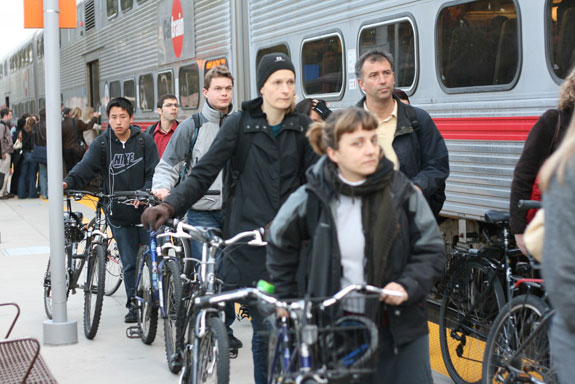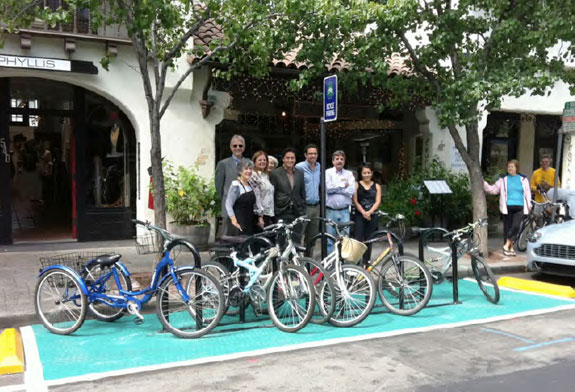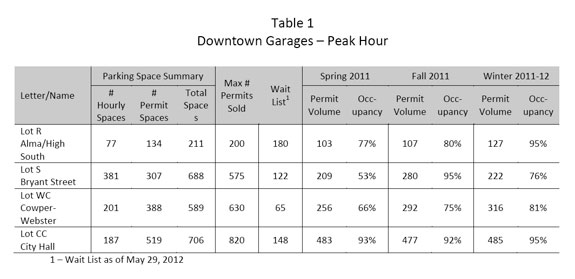
For the first time in 15 years, Palo Alto's outdated parking policies are being reviewed, and planners will consider recommending sustainable parking principles in the downtown core to better manage the supply. The affluent Silicon Valley city has not had a comprehensive examination of its parking strategies since 1997, when it installed four color-coded parking zones downtown. There is a two-hour limit in each zone but all curb parking is free.
“I think everything's on the table right now. We don't want to exclude anything at this particular state,” Jaime Rodriguez, the city’s chief transportation official, told Streetsblog.
The study will explore charging for on-street parking, installing SFPark-like meters and sensors and a number of transportation demand management (TDM) measures to discourage single-occupant vehicle trips. Advocates pushing for parking reform hope that Palo Alto will follow cities such as Redwood City or Boulder, Colorado, which have implemented innovative performance-based parking policies and benefit districts that helped spruce up their downtowns and boost business. Two other Peninsula cities -- San Mateo and Burlingame -- also charge for on-street parking in their downtown business districts.
Palo Alto Mayor Yiaway Yeh led the charge for a comprehensive parking study at the July 16 City Council meeting. A proposed residential parking permit program for the Professorville neighborhood was nixed in favor of the review. Some residents in Professorville and Downtown North have complained that downtown employees who take advantage of unpriced on-street parking on residential streets make it difficult for them to park near their homes.
Some influential merchants and residents are framing the problem as a downtown parking shortage. "There has always been a parking deficit in the downtown," Barbara Gross, board member of the Palo Alto Downtown Business and Professional Association, told the City Council. “Parking has a direct influence on the success of the business district and has overflow impacts on surrounding residential areas."
Bending to this perception, planners will look into building more garages "on three or four sites downtown," according to a document city staff distributed to the City Council. Meanwhile, advocates pushing for parking reform vow to fight the garages, saying there is no need for new spaces. The real problem, they say, has to do with the fact that downtown Palo Alto offers mostly free parking.
"How can there be a deficit if you're giving it away for free? In other words, the problem is that you're mismanaging your current supply," said Irwin Dawid, who sits on the transportation committee of the Sierra Club's Loma Prieta chapter and writes for Planetizen.
In downtown Palo Alto, there are currently 1,100 free on-street spaces and about 2,194 off-street spaces located in four public garages. The city offers one-year permits to park in the garages at a cost of $420, and there is currently a waiting list. However, with the ever-present option of free curb-side parking luring some drivers, a number of spaces in the garages -- including the ones for permit holders -- frequently sit empty:
In an interview with Streetsblog, the city’s planning director, Curtis Williams, agreed that putting a price on curbside parking would improve the situation, but said winning merchants won’t be easy.
"The merchants in downtown Palo Alto have long held strong beliefs that free parking is one of the reasons they're so successful here, and I know that's not new to Palo Alto. We need to do a lot of education and work with them and probably gradually be able to roll something out,” Williams said.
Palo Alto installed 800 parking meters in 1947 but the City Council ordered them removed after the Stanford Shopping Center was expanded in the 1970s. As one of the first big malls on the West Coast, its abundant, free parking devastated retail stores on University Avenue.
Today, University Avenue retail is doing well, and downtown Palo Alto is suffering from the effects of its underpriced curbs. To muster the will to tackle this problem, the city could take a page from UCLA urban planning professor Donald Shoup. In his book “The High Cost of Free Parking,” Shoup writes that “cities can create the necessary political support for market-price curb parking if they return the resulting revenue to the neighborhoods” through community benefit districts.
A report on U.S. parking policies prepared by the Institute for Transportation and Development Policy notes that “in 20 to 30 special parking districts, in cities as varied as Boulder, Colorado, Los Angeles and San Diego, meter revenues support streetscape improvements to attract more retail business.”
A growing number of cities, the report said, are beginning to recognize the correlation between smart parking policies and safe streets that make biking, walking and transit an easy option.
“I do believe that the pricing should help people to number one, find available parking, and number two, ultimately help steer them toward other modes, but we also have to enhance the convenience and serviceability of those modes at the same time to make that transition,” said Williams.
Palo Alto already has a transit-rich downtown that is served by three transit agencies. The Caltrain station is the second busiest on the system and downtown gets high marks for being walkable and bikeable.

The city became a pioneer in bike facilities in the 1980s when it built the nation’s first bicycle boulevard on Bryant Street. Palo Alto currently boasts higher walking and bicycling numbers than many other cities in Silicon Valley, and earlier this month the City Council unanimously passed an updated Bicycle and Pedestrian Master Plan “to solidify its status as one of the most bicycle friendly communities in California, if not the country.” To the delight of bicycle advocates, the city council also recently approved a permanent road diet on California Avenue, despite calls from some merchants that the city first conduct a trial.
A Climate Action Plan adopted in 2007 acknowledges that free parking encourages workers to drive, contrary to the city’s goals. The plan envisions a 15 percent reduction in greenhouse gas emissions “from 2005 levels by 2020." Currently, according to a report prepared by Alta Planning + Design, “automobile travel comprises 36 percent of total GHG emissions within Palo Alto." Shoup has long stressed that circling for parking is a major source of pollution and congestion on city streets.
"We're doing a lot to encourage people not to drive," said Rodriguez, the transportation chief, who added that the city has been encouraging companies to provide incentives for their employees to take transit, bike or walk, including offering free transit passes and housing subsidies to live close to downtown. Many already do. Palantir Technologies, he said, is one such company that offers those benefits.

While the parking study will focus on a variety of options, including efficiencies in the garages and adding attendant parking, Rodriguez said he doesn't think Shoupian principles may necessarily work for Palo Alto, but it's something he plans to look into. The study will take about six months to complete and it will ultimately be up to the City Council to decide whether to reform the city's parking policies.
"It's an exciting opportunity from a parking management perspective because in a way it's a clean slate, but it's also difficult to implement change and it requires a lot of stakeholder input," he said.
Andrew Boone, a volunteer advocate with the Silicon Valley Bicycle Coalition's Palo Alto team, recently wrote a piece for Peninsula Transportation Alternatives pointing out that "such policies might be politically difficult to enact right now, but that's mostly because paying for parking is a new concept in Palo Alto, and most residents are unfamiliar with actively-managed dynamically-priced parking systems."
"Residents of downtown neighborhoods," he added, "would benefit due to reduced demand for parking in front of their homes. Workers and visitors would benefit as well, with conveniently available parking at all times. And everyone would benefit from reduced traffic congestion and safer streets - even people who never park at all."
This story is part of Streetsblog San Francisco's coverage of Silicon Valley. Got a tip or story idea we should be covering in Silicon Valley? Email bryan@sf.streetsblog.org.





